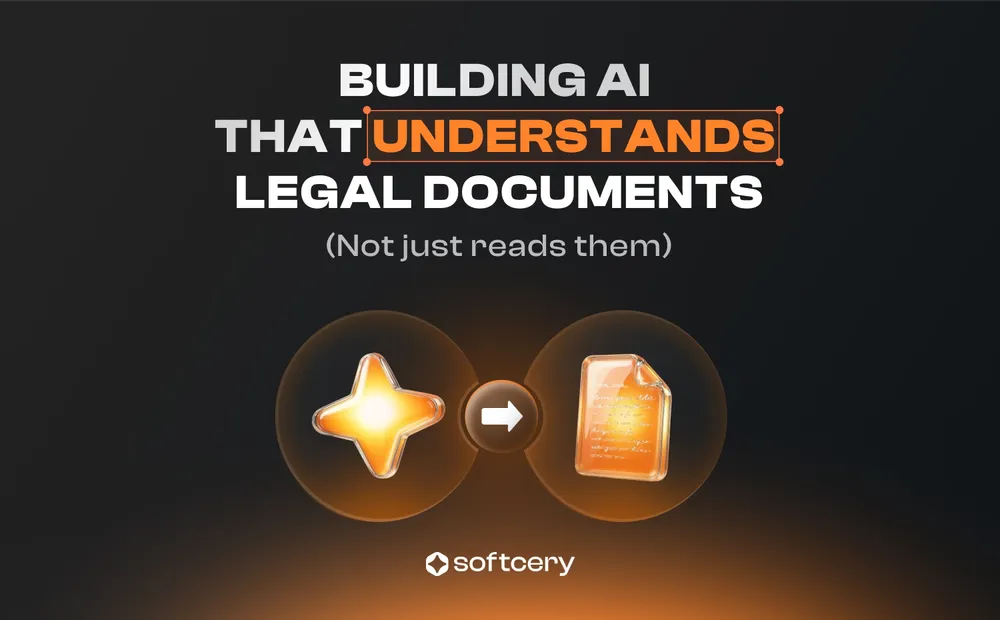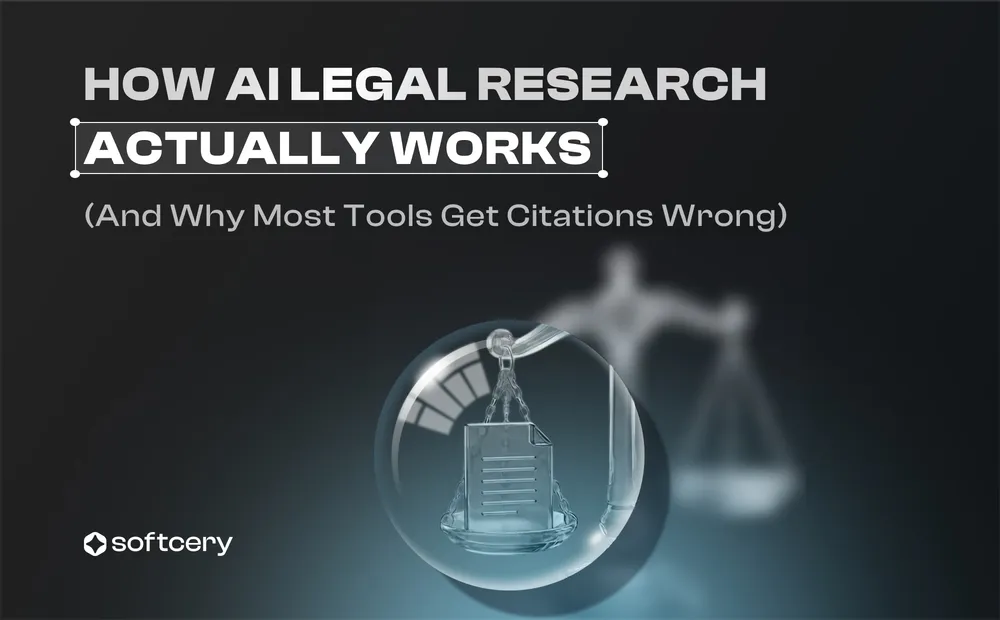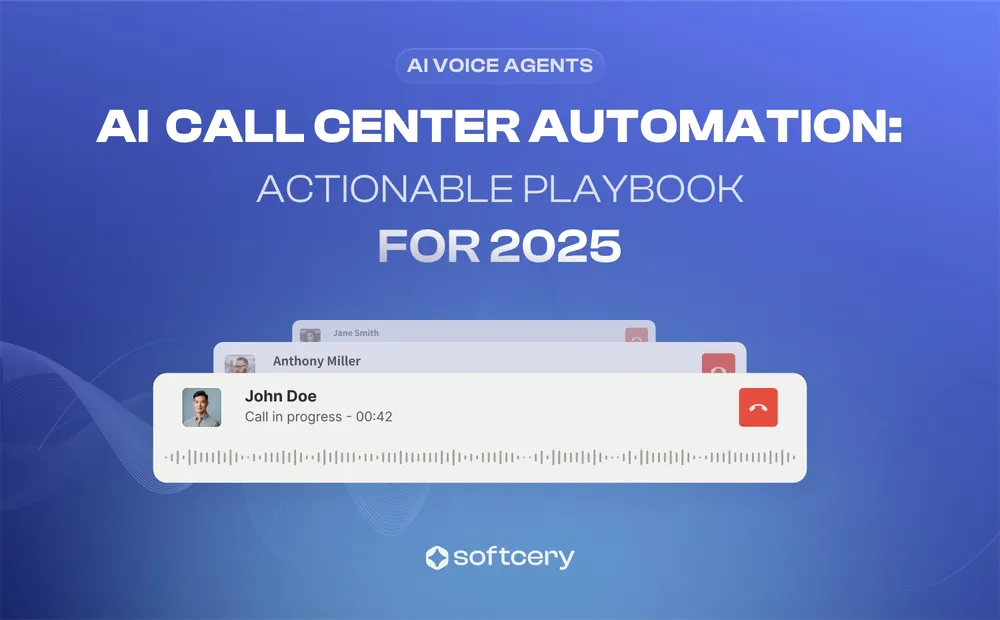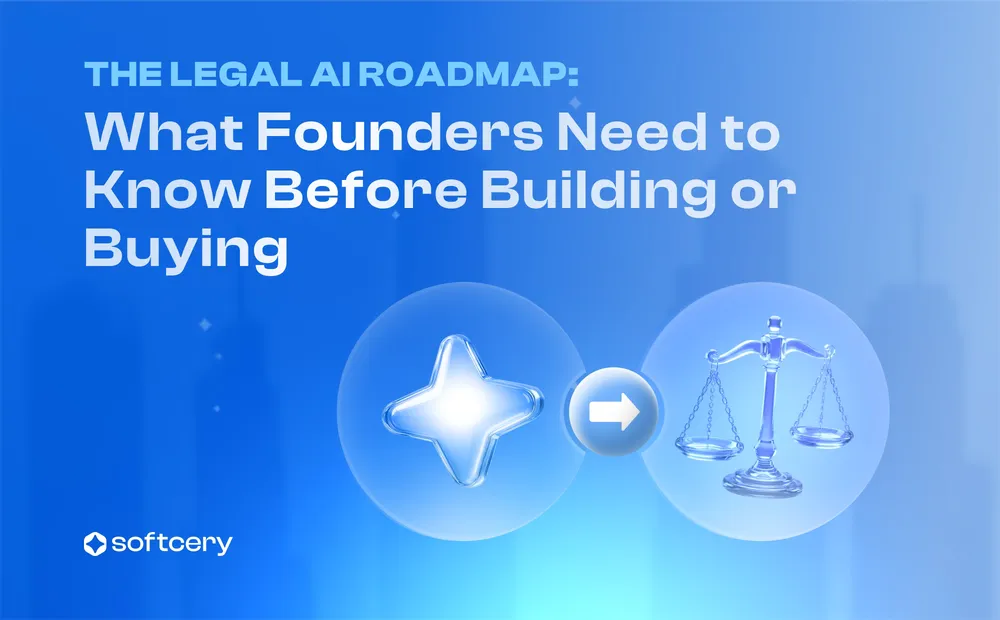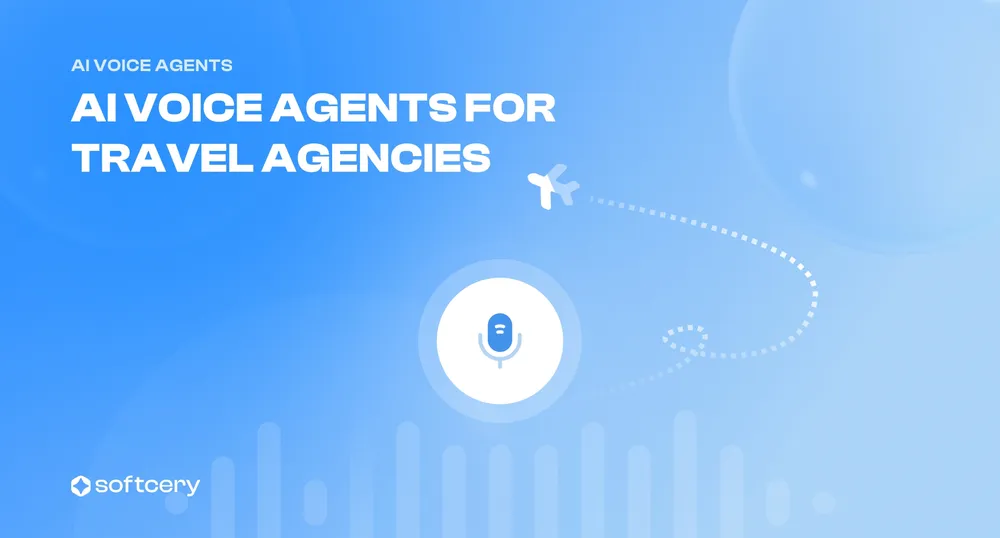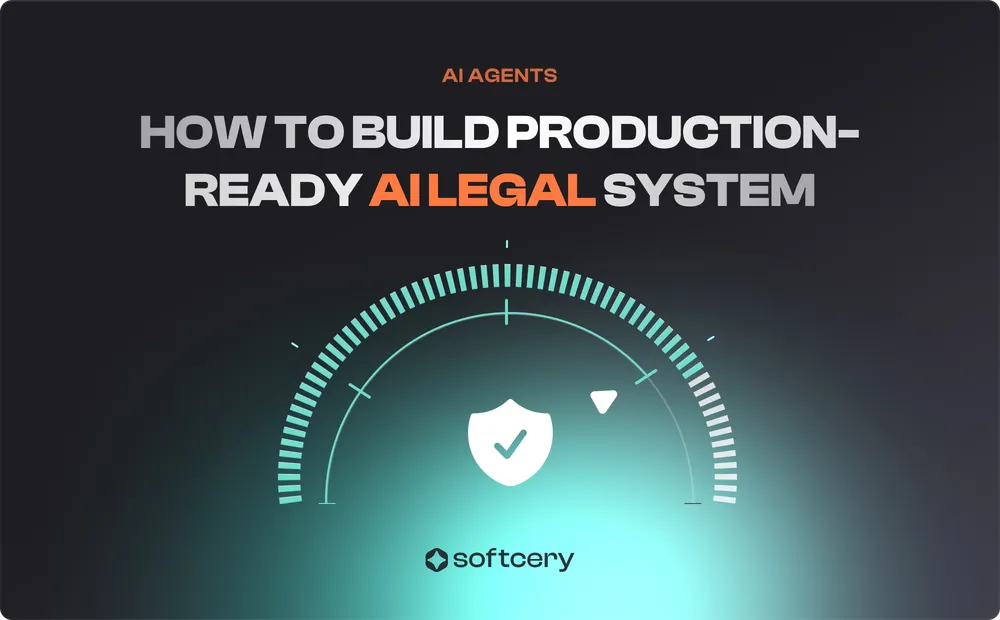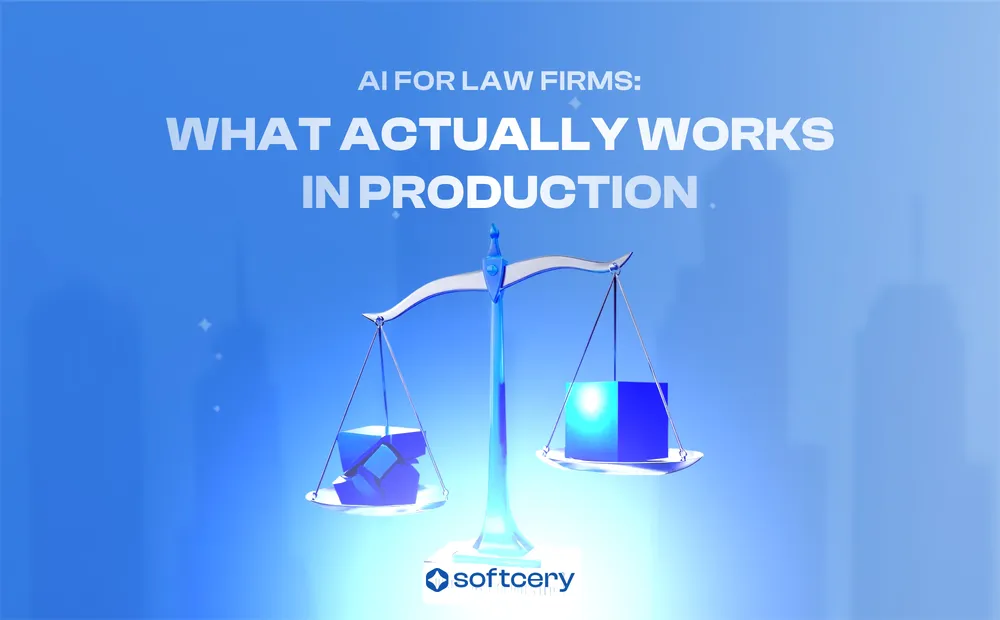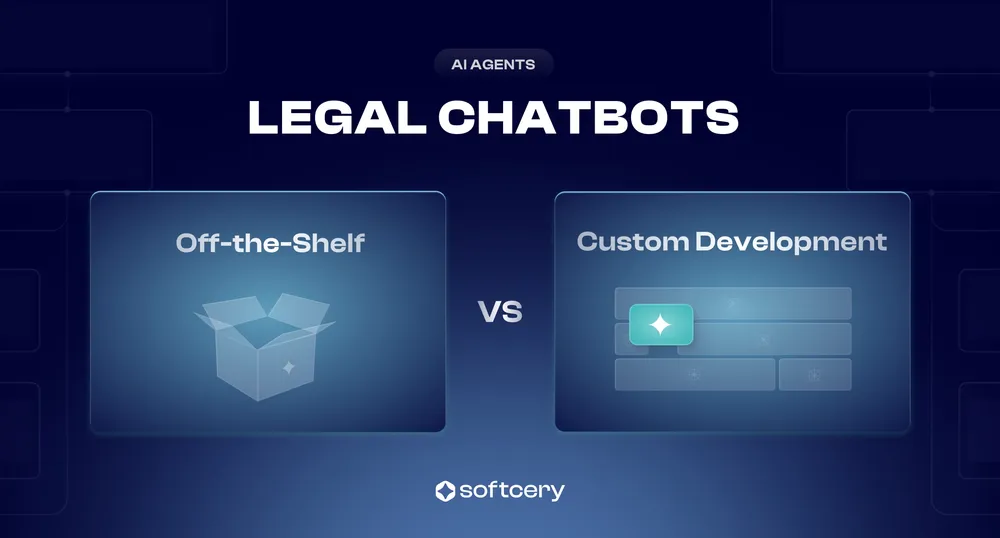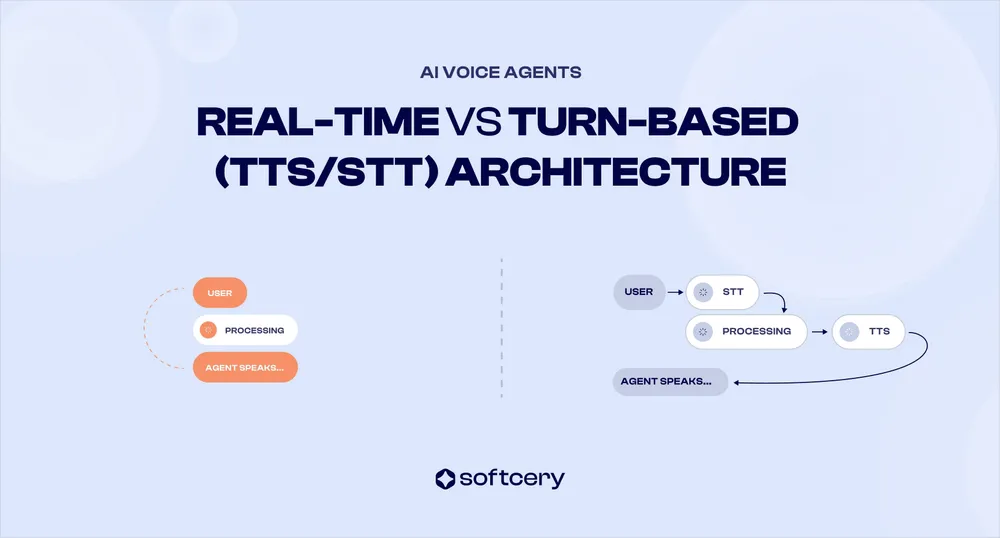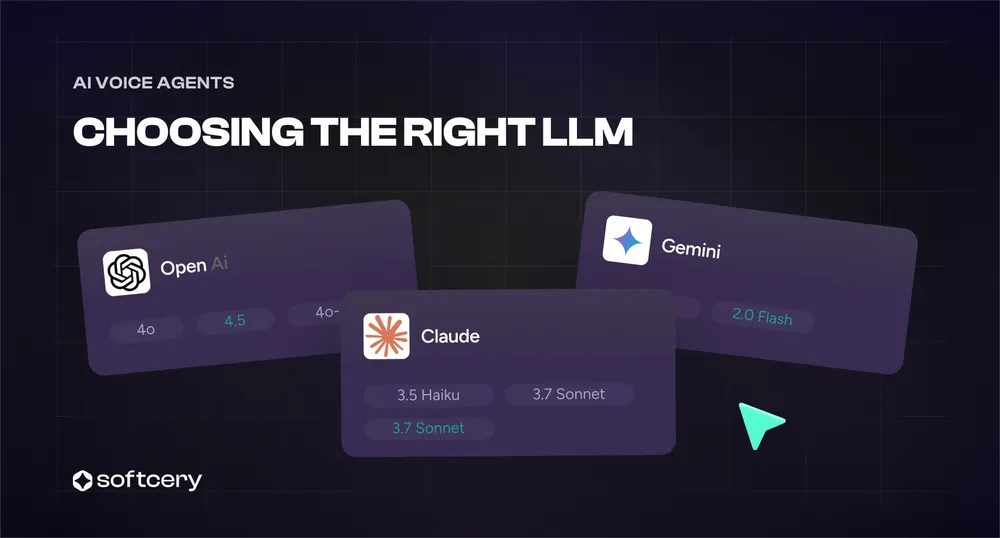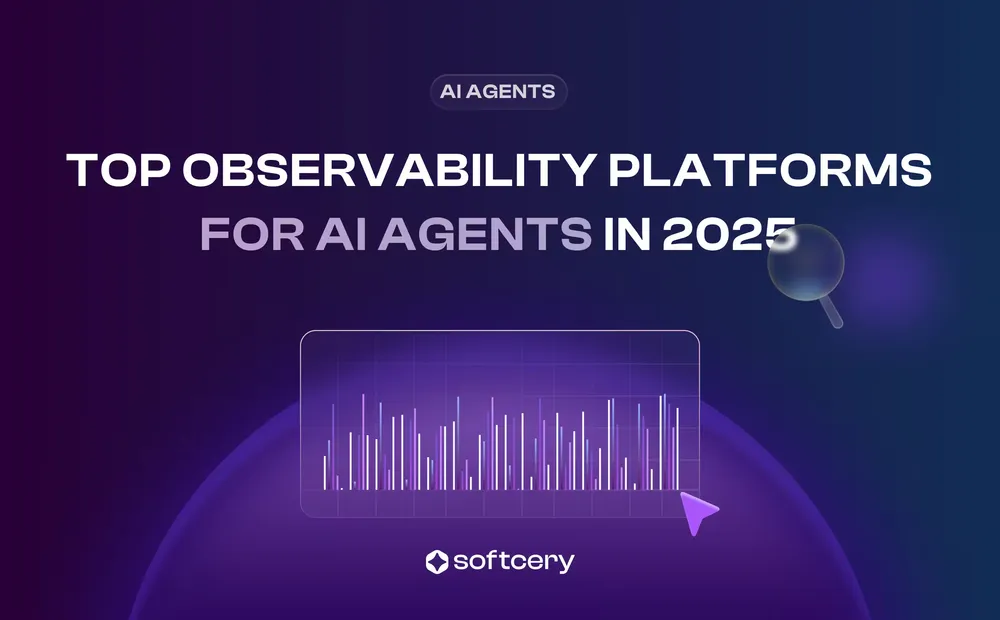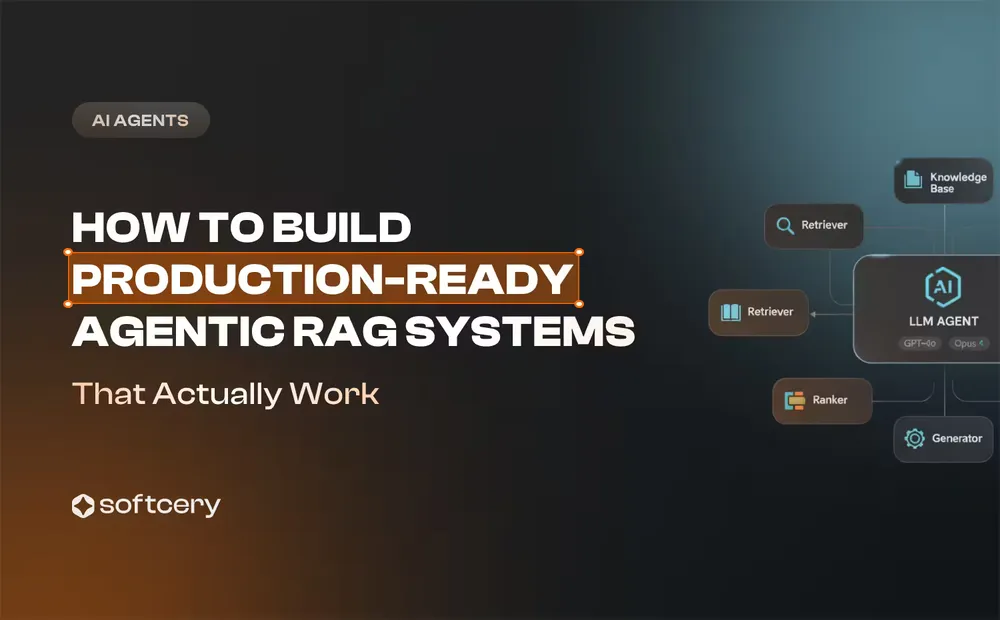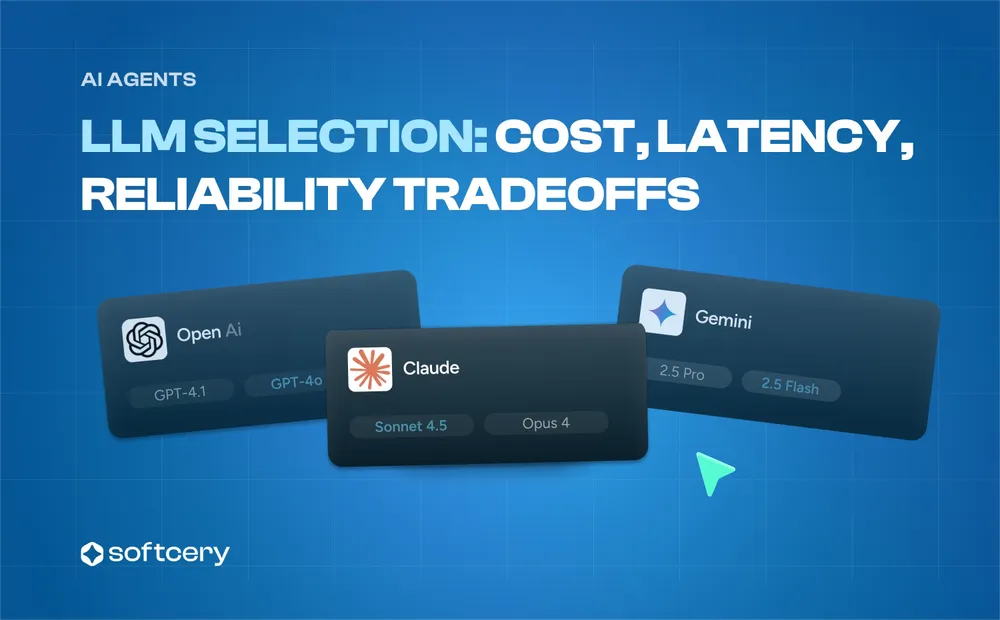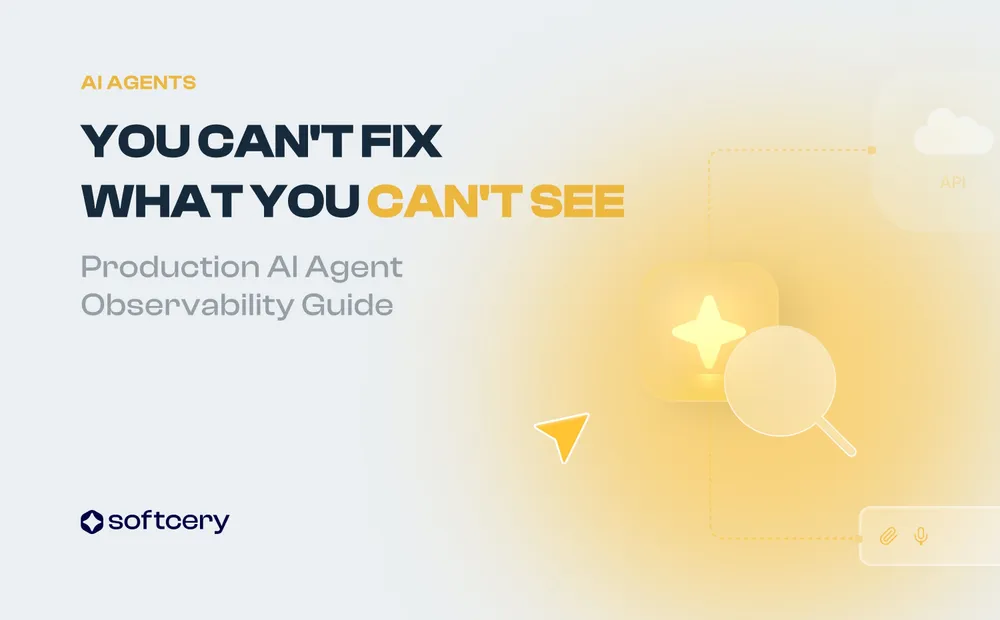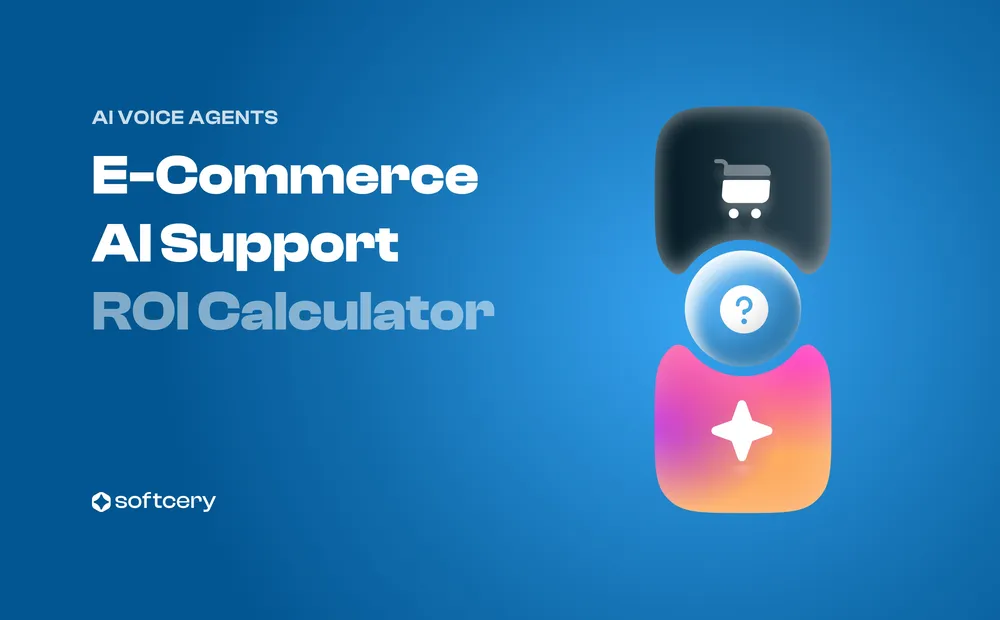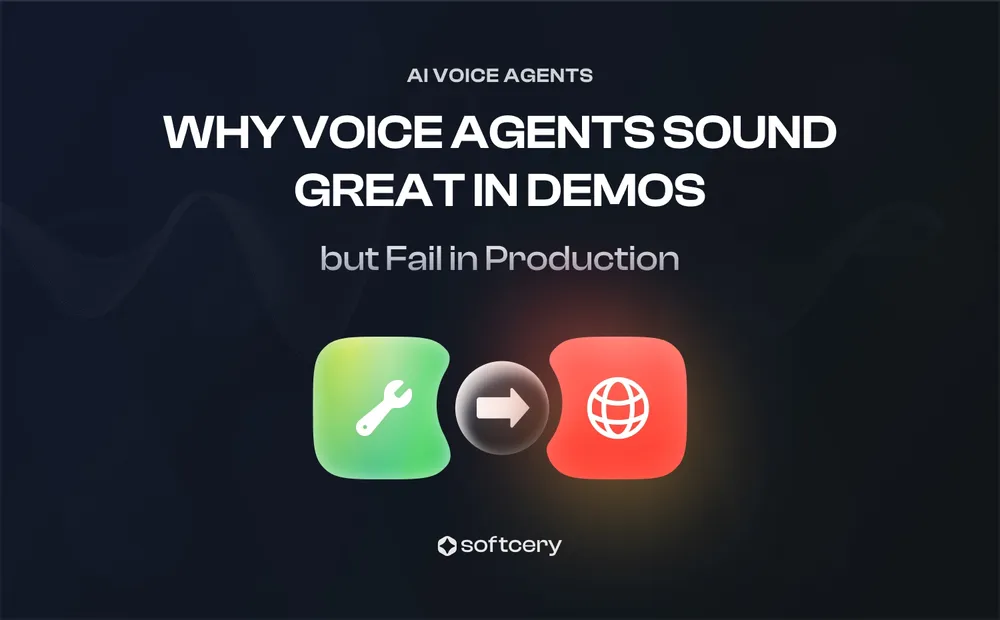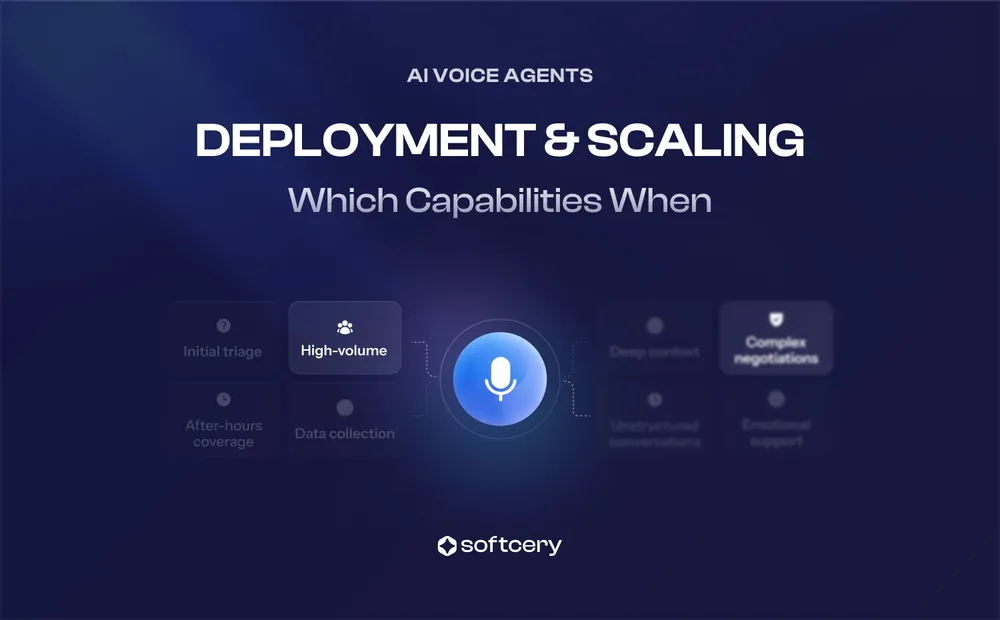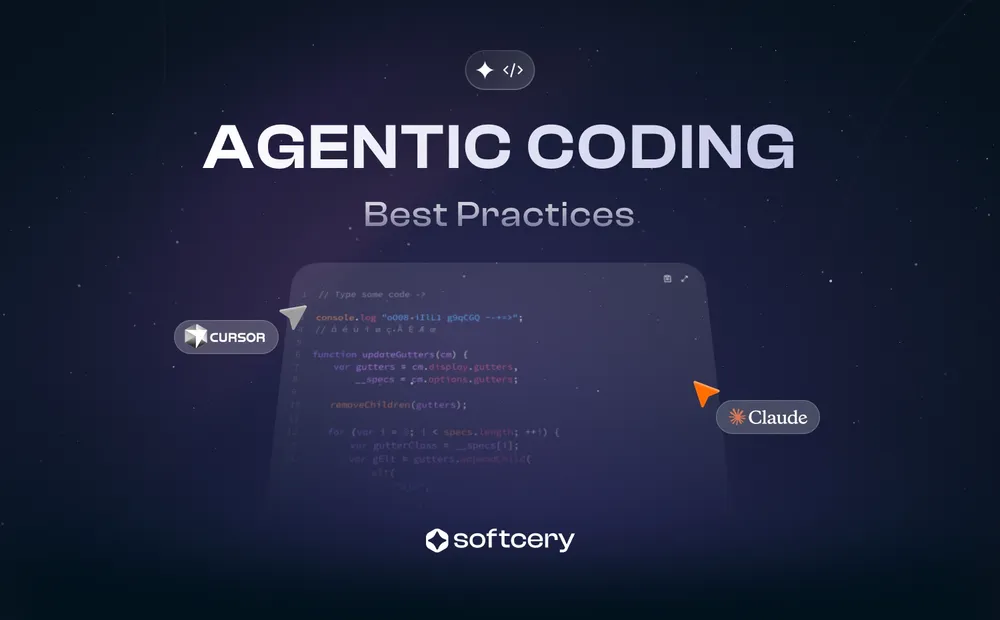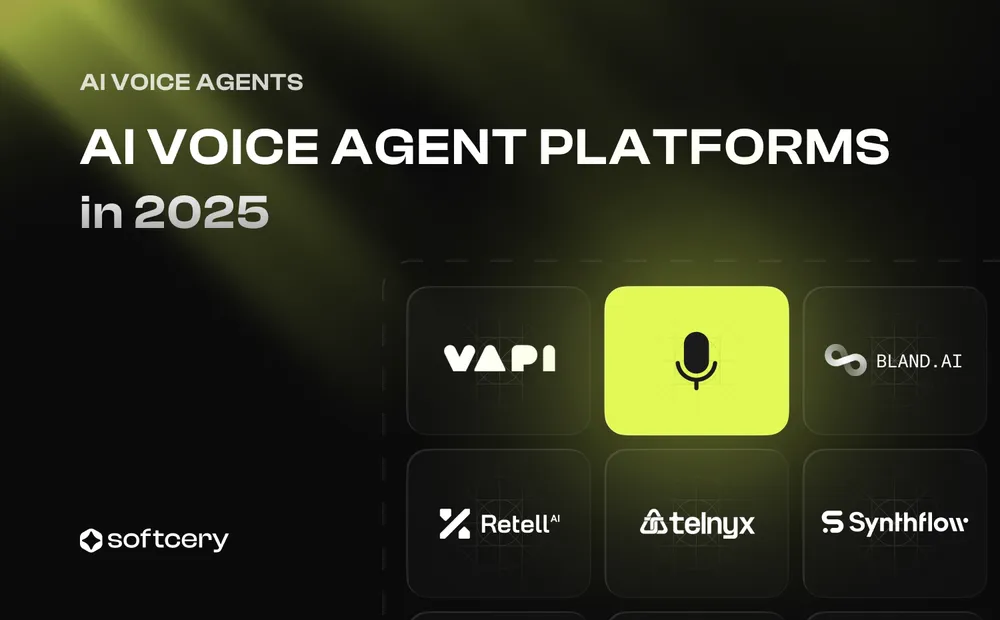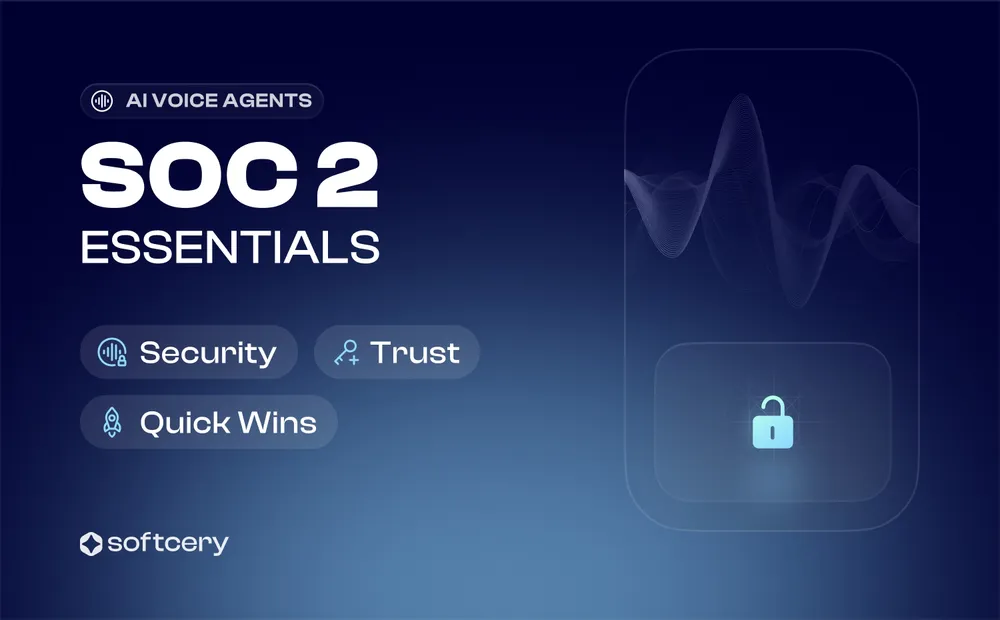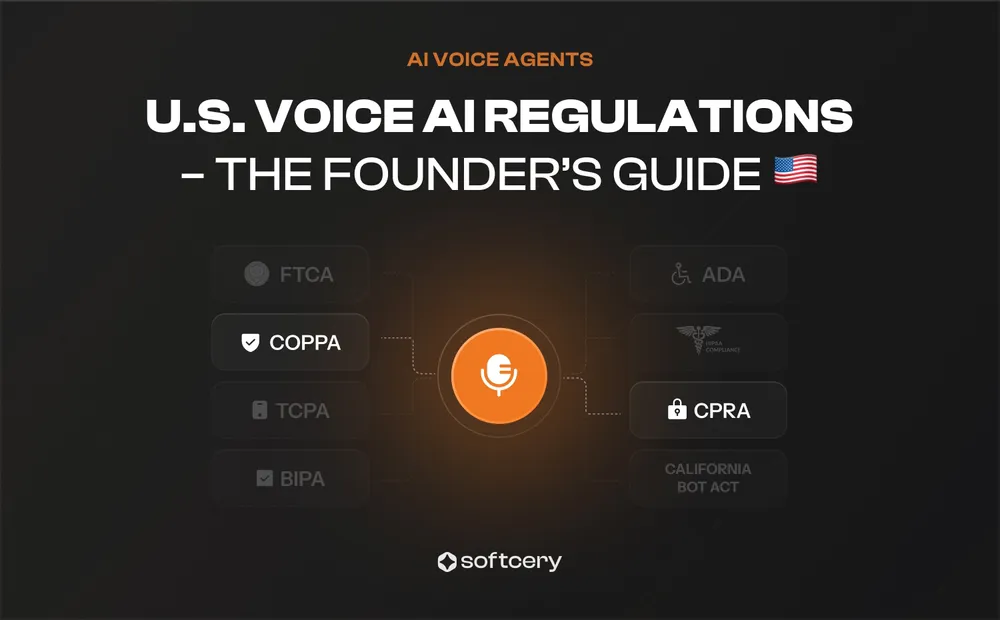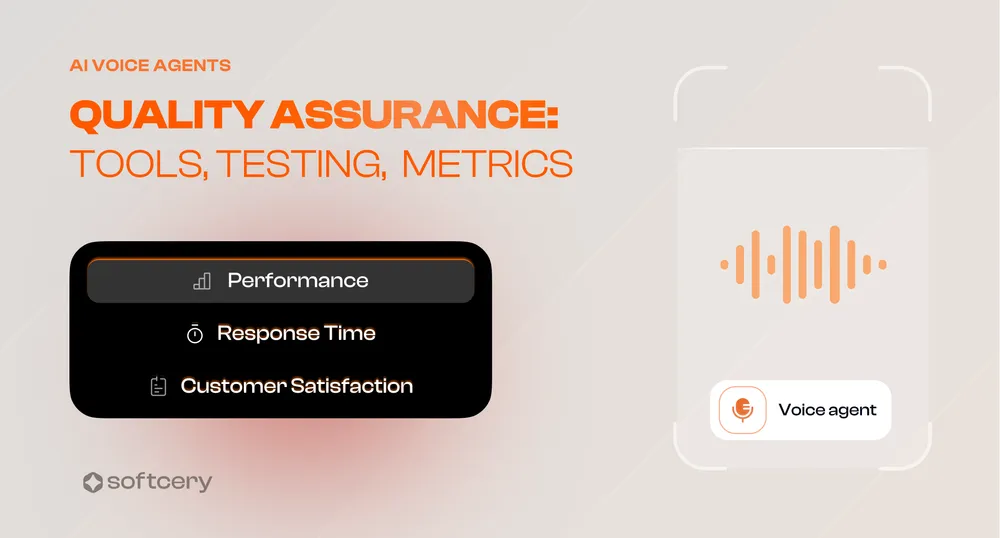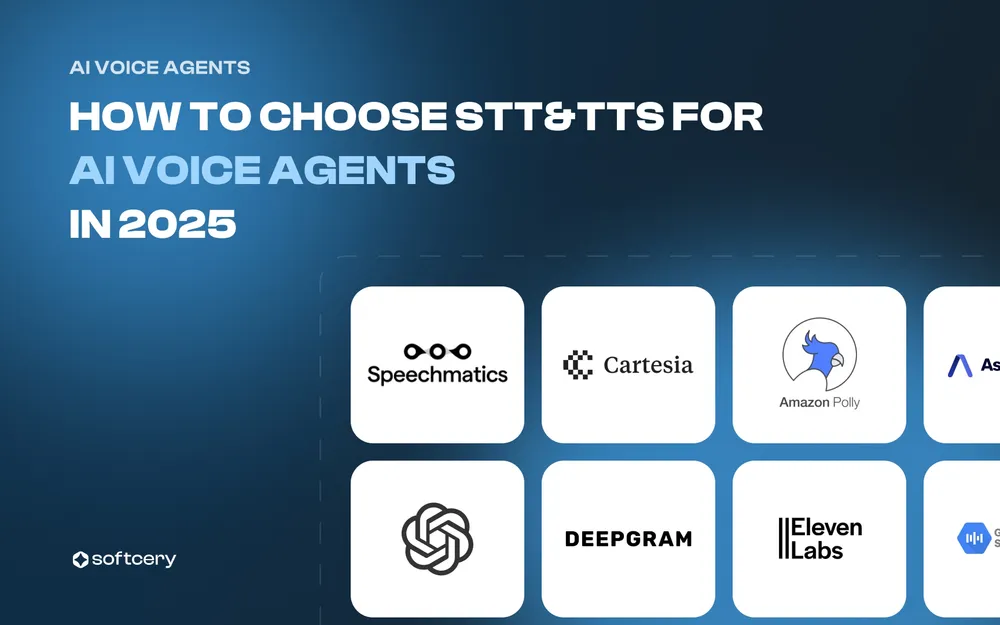Custom AI Voice Agents: The Ultimate Guide
Last updated on November 27, 2025
AI voice agents are sophisticated software systems that leverage artificial intelligence (AI) technologies, primarily Natural Language Processing (NLP) and speech recognition, to understand, interpret, respond to, and interact with human speech. They are specifically designed for specialized task execution within business environments.
Why Custom AI Voice Agents Matter: Key Benefits and Business Impact
- 24/7 availability across time zones with no wait times or missed queries.
- Cost optimization - Off-the-shelf solutions often charge per interaction or per minute. Custom agents can reduce long-term costs, especially at scale.
- Massive scalability – handle thousands of conversations in parallel without performance loss.
- Better use of human agents – focus staff on complex, high-impact issues.
- Consistent, policy-compliant responses with no drift, no fatigue, no deviation.
- Context-aware conversations that feel relevant and natural, not scripted.
- Seamless integration with CRMs, ERPs, helpdesks, and other enterprise systems.
- Multilingual and accent support for global teams and diverse user bases.
- Rich behavioral data and insights extracted from every interaction.
- Built-in infrastructure value – not just a chatbot, but a scalable operational asset.
1. When to Choose Prebuilt AI Solutions vs. Custom AI Voice Agents
The decision to build an AI voice agent in-house or purchase an off-the-shelf solution is a strategic one. It comes down to identifying what differentiates your company and allocating your resources accordingly. If voice automation is not a core part of your competitive edge, outsourcing the undifferentiated heavy lifting often makes more sense.
| Use Prebuilt Solutions | Build Custom Agents |
|---|---|
| You need to launch quickly with minimal internal development effort. | You need deep integration with proprietary systems, secure backends, or internal tools. |
| Your use case is straightforward or standard (e.g., FAQs, appointment booking). | Your agent must reflect domain-specific workflows or regulatory requirements (e.g., healthcare, legal, finance). |
| You lack in-house AI/voice engineering expertise and can’t build a full stack internally. | You require full control over infrastructure, data privacy, or latency – especially in regulated or sensitive setups. |
| You’re in the PoC stage and need to validate market demand before committing to a larger investment. | You want to build a unique experience that differentiates your brand and can’t be achieved with templates. |
| You’re working with a tight budget and need a lower-cost path to deployment. | You want long-term cost optimization and to avoid vendor lock-in or per-minute pricing traps. |
| You want best-in-class functionality without managing infrastructure or maintenance. | You need to tune every layer of the stack – from model prompts to backend logic – for performance or compliance. |
| You prefer predictable SaaS pricing over complex infra, LLM, and telephony cost management. | You want a highly optimized, lean deployment model with control over runtime costs. |
| You need scalable, vendor-managed security, uptime, and compliance out of the box. | Your procurement process requires you to demonstrate internal compliance and data handling transparency. |
| You want to leverage external expertise through an agency or vendor specializing in voice automation. | Your team has voice/AI talent and wants to retain intellectual property and control over innovation cycles. |
| You want internal teams to focus on your core product and not on maintaining an AI system that isn’t central to differentiation. | Voice automation is a strategic part of your product or customer experience. |
Important: Custom doesn’t mean in-house.
You can outsource custom development to partners like Softcery – who bring technical depth, production experience, and the ability to fine-tune every part of the voice stack.
While prebuilt solutions offer speed and convenience, they rarely deliver lasting competitive advantage. If voice is central to your user experience, brand identity, or operational edge, building your own agent is the only way to gain full control. Custom development enables you to fine-tune behavior, enforce strict security and compliance, and continuously adapt the agent to evolving business needs. Over time, the ability to optimize every layer – from latency to language – compounds into real strategic value.
2. Anatomy of a Voice Agent
Building a custom AI voice agent starts with understanding the core architecture.
A working voice agent includes several tightly coupled systems that must operate with low latency, high accuracy, and full reliability.
How Does the Core Architecture of an AI Voice Agent Work?
The core components of a voice agent include:
STT (Speech-to-Text / ASR): Converts user speech into structured text input. Quality varies drastically between engines - accuracy under noisy conditions, support for accents, and real-time streaming performance are all critical. Choose STT based on latency tolerance and domain-specific vocabulary support. Here you will find detailed information about STT, key suppliers, and important metrics.
TTS (Text-to-Speech / Speech Synthesis): Converts the response back into audio. Tradeoffs here include latency, naturalness, and language coverage. Providers like PlayHT, ElevenLabs, and Amazon Polly vary widely in voice quality and responsiveness. Some TTS engines cache audio to reduce delay; others generate speech on demand. In our article, you can find the key aspects you need to understand TTS.
LLM Layer: Once transcribed, the input is passed to an LLM engine. This layer determines the intent, extracts relevant entities, and produces a response, based on pre-configured instructions (LLM prompt). Your choice here depends on control needs, hallucination risk, and available compute. Learn how to choose the right LLM for your needs.
Logic Layer: The logic orchestrator decides what to do with the LLM output. It handles routing, validation, business rules, and whether to escalate or trigger backend processes. It’s where your domain-specific rules live.
Integration Layer: This handles API calls, database lookups, CRM updates, and custom business logic. It’s the glue between your voice agent and operational systems.
Telephony / Channel Layer: Connects to phone systems via SIP or WebRTC. Real-time agents must sync closely with telephony events (barge-in detection, call transfer, etc.).
All of these layers must work together within tight timing constraints. A failure in one will degrade the whole system.
Realtime vs Turn-Based Voice Agents: Tradeoffs and Decision Points
The biggest architectural decision is whether to build a realtime or turn-based voice agent. For an in-depth breakdown, see Voice Agents: Realtime vs Turn-Based Architecture.
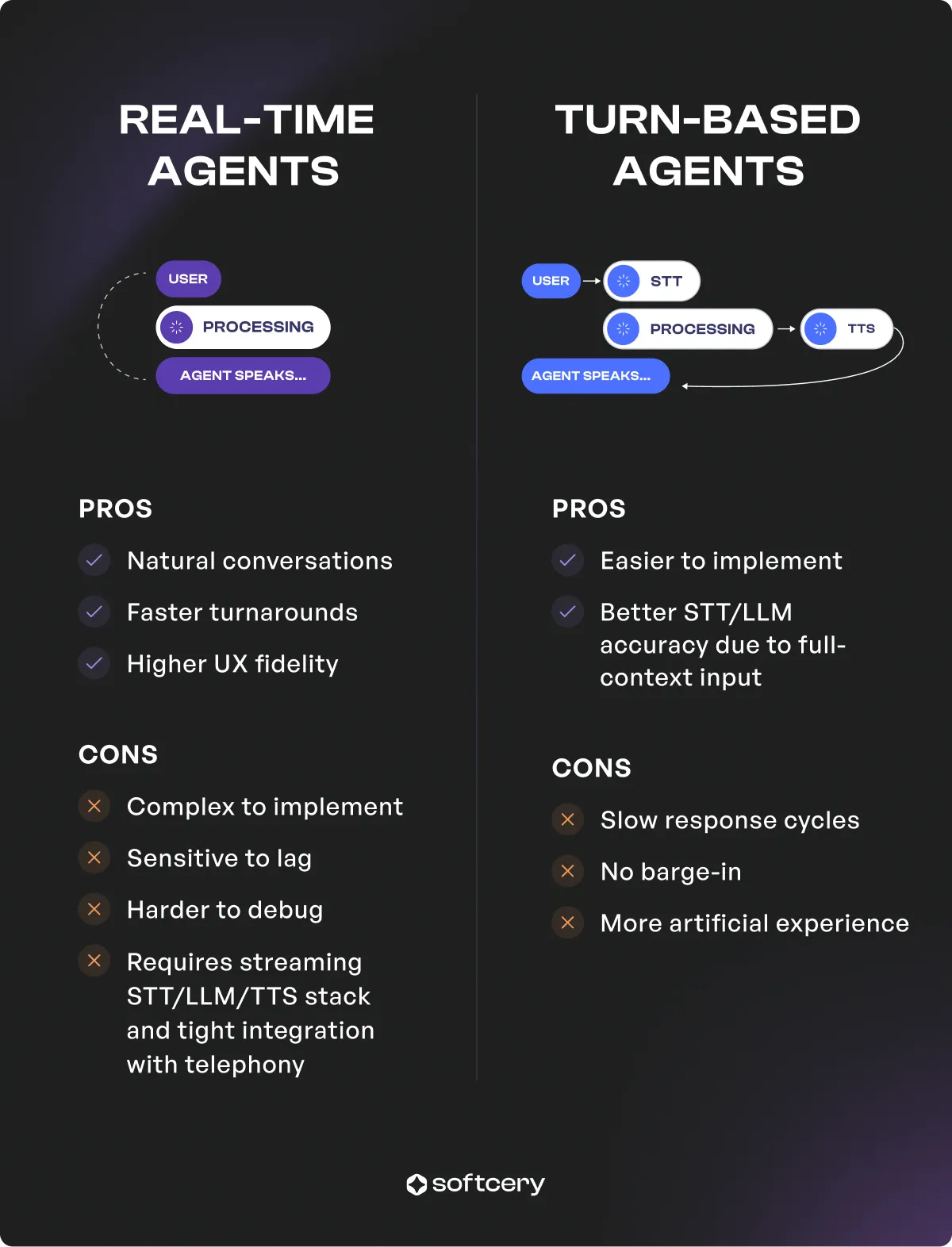
How Do Voice Agents Connect with CRMs, ERPs, or Internal Tools?
Custom voice agents aren’t standalone systems. They drive value when embedded into your existing operational stack - whether that’s a CRM, ERP, ticketing system, or proprietary database. For guidance on choosing the right deployment infrastructure and integration approach, see our platform comparison guide. Integration isn’t optional. It’s the only way to deliver personalized, transactional, and context-aware automation.
Common Integration Methods:
RESTful APIs Most modern platforms expose REST endpoints. Voice agents call these to retrieve customer records, create tickets, or update statuses. For example:
- Pulling customer account info by phone number from a CRM
- Logging an interaction into Salesforce or HubSpot
- Triggering workflows in tools like ServiceNow or Zendesk
Direct Database or Middleware Access For legacy systems with no usable APIs, the agent may interact through:
- SQL queries (with strict sandboxing and auditing)
- Middleware connectors that wrap old systems in an API layer
- RPA or scripting layers for systems with no integration point
Authentication and Session Handling If secure access is needed, voice agents may:
- Request OTP codes or security questions
- Use JWT or OAuth tokens for user session management
- Maintain context across multiple calls or user actions
Integration Scenarios
- CRM (e.g., Salesforce, HubSpot): Fetch customer history, update lead status, log call outcomes
- ERP (e.g., SAP, NetSuite): Check inventory, confirm delivery dates, validate purchase orders
- Custom Systems: Connect to internal portals, finance tools, or compliance workflows using tailored API adapters
- Support Systems (e.g., Zendesk, Freshdesk): Create and update tickets, assign priorities, trigger escalations
Considerations
- Latency: Integration must complete within a few hundred milliseconds to avoid breaking real-time voice interactions.
- Security: Data passed between systems must be encrypted, authenticated, and logged.
- Error Handling: Voice agents must gracefully degrade or retry if a downstream system is unavailable.
3. Cost & Build Options for AI Voice Agents
How much does it cost to run a voice agent?
Every AI voice agent interaction has a real, measurable cost. Most of that cost comes from three core services: transcription (STT), language processing (LLMs), and voice synthesis (TTS). Add infrastructure, APIs, and orchestration logic, and your cost per call starts to climb fast.
Use our AI Voice Agent Cost Calculator to:
- Compare STT, LLM, and TTS vendor pricing
- Estimate per-minute and monthly costs based on expected usage
- Analyze total cost of ownership across deployment scenarios
- Identify key cost drivers and opportunities to optimize
You’ll see exactly how STT, LLM, TTS, and infra stack up – and where to optimize.
4. AI Voice Agents Implementation Lifecycle
How do you decide what should or should not be automated?
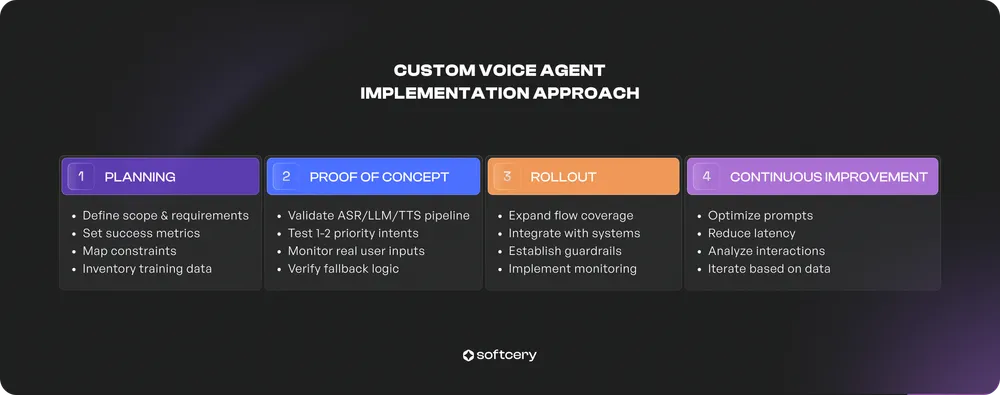
Don’t automate for automation’s sake. Focus on strategic automation.
Identify Repetitive, High-Volume Tasks: These are prime candidates. Think password resets, order status checks, appointment scheduling, or common FAQ answers. These are often tedious for human agents and can free them for more complex issues.
Look for Predictable Dialogue Flows: Can the conversation be mapped with relative certainty? If the dialogue path is highly variable or requires significant human empathy and nuanced understanding (e.g., conflict resolution, complex sales negotiations), automation is risky.
Assess Data Availability: Can the AI access all necessary information to handle the task? If the data is siloed, messy, or non-existent, automation will fail.
Calculate ROI: Will automating this specific task provide a tangible return on investment? Consider cost savings, efficiency gains, and improved customer experience. Avoid automating low-impact tasks.
Define Clear Boundaries: Be explicit about what the AI can and cannot do. This manages user expectations and helps design effective escalation paths.
How Should Implementation of a Custom Voice Agent be Approached?
Softcery approaches voice agent implementation as a staged, productized process that aligns with enterprise architecture principles. The focus is on delivering measurable business outcomes through tightly scoped iterations, system integration, and continuous optimization.
Planning: Define Scope, Requirements, and Constraints
The planning phase establishes the technical and operational foundation. Key activities include:
- Use Case Definition: Prioritize high-impact, repetitive workflows suitable for automation (e.g. customer support triage, order status, appointment handling).
- Success Metrics: Establish quantitative benchmarks - automation rate, containment, average response latency, call completion, handoff rate to human agents.
- Constraint Mapping: Document infrastructure limitations, legal/regulatory compliance, language support, and data governance policies.
- Data Inventory: Identify training datasets - such as call transcripts, user utterances, and internal documentation - for intent design and prompt engineering.
Failure to adequately define these parameters results in architectural drift and rework downstream.
Proof of Concept (PoC): Validate Core System Architecture
A PoC verifies the technical viability of the full voice agent pipeline in a low-risk environment. Scope is intentionally narrow to validate core components under realistic conditions:
- Pipeline Validation: Deploy ASR (STT), LLM, and TTS in a live loop to assess real-time transcription, inference, and speech synthesis quality.
- Flow Limitation: Limit to 1–2 priority intents to validate interaction accuracy, latency thresholds, and infrastructure compatibility.
- Input/Output Monitoring: Capture real user inputs (not synthetic prompts) and validate outcomes across modalities (voice, text).
- Fallback and Recovery: Test interruption handling, barge-in support, and escalation logic to humans or external systems.
This stage ensures that selected vendors, models, and tools are production-grade and aligned with technical expectations.
Rollout: Expand Coverage and Integrate Systems
Once the architecture is validated, the rollout phase scales functionality and embeds the agent into the operational stack.
- Flow Expansion: Add secondary and edge-case scenarios, including multilingual support if applicable.
- System Integration: Connect the agent to CRMs, ERPs, ticketing systems, data warehouses, or custom APIs using secure authentication protocols.
- Operational Controls: Establish guardrails - session timeouts, maximum retries, fallback thresholds - and define SLAs.
- Monitoring & Observability: Implement end-to-end observability - latency tracking, token usage, error tracing, call quality metrics.
- Security Compliance: Apply encryption, authentication, and access control consistent with internal IT security standards.
Rollout must be phased, monitored, and aligned with change management practices to ensure operational stability.
Continuous Improvement: Maintain and Optimize Over Time
Voice agents require active lifecycle management. This phase focuses on improving performance, stability, and ROI.
- Prompt Optimization: Refine LLM prompts based on actual usage to reduce hallucinations, repetition, and token waste.
- Latency Optimization: Identify and reduce bottlenecks across the pipeline - model inference time, streaming delay, TTS generation.
- Interaction Analytics: Track user behavior, drop-off points, confusion signals, and escalation frequency to guide redesign.
This is not an optional phase - it is essential for ensuring the system remains performant, aligned with business needs, and competitive over time.
5. QA, Monitoring & Observability for AI Voice Agents
1. Prompt Testing: Validate LLM Instructions
Directly test system prompts and user prompts in isolation to ensure the LLM responds with the intended tone, structure, and logic. Useful for evaluating behavior without running full conversations.
Prompt testing helps catch hallucinations, flow misalignment, or unwanted behaviors introduced during prompt iteration. It is particularly critical when chaining multiple instructions or fine-tuning role behavior.
Usage Scenario: During initial prompt engineering, after updating LLM instructions, or before production rollout of prompt-dependent behavior.
2. Functional Testing: Validate Core Voice Flows
Script real conversational flows – such as appointment scheduling, order status checks, billing inquiries, or basic troubleshooting – and verify the agent responds with the expected behavior. Functional tests check whether the full voice pipeline (STT → NLU/LLM → logic → TTS) performs accurately and reliably across common user intents.
This is the closest equivalent to manual QA for voice agents. However, the main limitation is test drift: every time you update logic, models, or flow branching, your scripted tests need to be updated too. Without constant maintenance, your tests lose coverage and give false confidence.
Usage Scenario: Pre-launch regression tests, CI/CD pipelines, release validation environments where deterministic behavior must be verified across key flows.
3. Integration Testing: Validate System Cohesion
Test the entire call flow from STT to backend APIs. This ensures different components – STT, NLU, business logic, TTS, external integrations – communicate correctly and handle edge cases in timing, handoff, and data structure transformations.
These tests help verify that the integration layer itself functions correctly – not just the individual components. For example, you may validate that STT output is being correctly passed to the logic layer, or that TTS is triggered with the expected content.
Usage Scenario: Pre-staging or post-merge validation; critical after changes to APIs, prompt routing, or external dependencies.
4. Regression Testing: Catch What Broke
Any change to models, prompts, logic, or integrations can break something. Automated regression tests re-run key conversation paths to detect unexpected behavior changes. This testing is especially important after modifying model prompts, upgrading STT/LLM/TTS components, changing routing logic, or adding new integrations. Without regression coverage, even small changes can silently break key use cases.
Usage Scenario: Post-deployment or prior to model upgrades.
5. Robustness Testing: Simulate Messy Reality
Validate agent behavior under poor conditions: loud background noise, thick accents, poor mics, fast/slow speech, or unexpected phrasing. Agents must either handle or gracefully fail and fall back.
Usage Scenario: Pre-production testing in diverse market environments.
6. Adversarial Testing: Ensure Model Safety
Use malformed, ambiguous, or intentionally manipulative inputs to probe the agent’s weaknesses. Adversarial testing helps uncover hallucinations, logic breakdowns, prompt leakage, and unsafe behaviors—especially in LLM-based systems.
These tests simulate real-world edge cases or malicious user behavior that may expose vulnerabilities. It’s essential for agents operating in regulated industries, customer support, or any context where output safety matters. Often performed manually by QA teams or augmented with adversarial evaluation frameworks.
Usage Scenario: Pre-production safety audits and continuous evaluation of live LLM-based agents.
7. Load and Scalability Testing: Stress the System
Simulate concurrent traffic and monitor system degradation under load. Test call concurrency, backend latency, and autoscaling behavior.
Usage Scenario: Before major product launches or seasonal peaks.
8. User Testing and Feedback Loops: Reality Check
Deploy to a controlled user group. Capture call transcripts, CSAT, resolution rates, and problem examples. Use feedback to refine prompts, intents, and logic. This is also one of the most effective ways to test LLM-driven agents in practice.
Usage Scenario: Pilot programs, post-launch tuning, and ongoing LLM prompt refinement based on actual user behavior.
Observability: See What the System Can’t Tell You
Voice agent systems are complex, multi-layered, and real-time. You can’t improve what you can’t see—so observability isn’t optional. It’s foundational for reliability, performance, and trust.
Start with end-to-end tracing: track each interaction across STT, LLM, logic, TTS, and integration layers. Use tools like LangChain to instrument prompts and monitor LLM behavior directly—if a response deviates or exceeds latency/error thresholds, you’ll know where to look.
Don’t just monitor your system. Track external dependencies—STT, TTS, LLM providers. Their drift or degradation becomes your failure. You may need to switch providers manually or automatically based on SLA violations or performance drops.
Observability should be business-aligned. Metrics should reflect real business impact, not just technical health:
- Task completion rate
- Fallback frequency and causes
- Response latency at each stage
- Prompt drift and hallucination triggers
- User sentiment over time
Design your monitoring around these flows. What matters varies by product, industry, and user expectations. Observability isn’t one-size-fits-all—it should evolve with your stack, user base, and model architecture.
Key Voice Agents Production Metrics
Voice agents operate in real time. When something breaks - users notice instantly. There’s no tolerance for delayed replies, misheard requests, or irrelevant responses. You don’t get a second chance to make a first impression. Once deployed, your agent needs 24/7 monitoring. The goal: detect quality degradation before customers do. They are core to operational success.
To ensure consistent quality at every stage, from prototype to production, focus on these key areas:
Latency: Track the total time from when the user stops speaking to when the agent starts responding. For real-time use, this must stay under 250 ms. Anything above 400 ms introduces noticeable lag, which breaks the conversational rhythm.
STT Accuracy: Monitor Word Error Rate (WER) across different user segments. Degradations in accuracy often correlate with environmental noise, unfamiliar accents, or mic quality issues. Establish baselines and set alert thresholds for spikes.
Intent Match Rate: This tracks how often the agent correctly identifies what the user wants. A drop here indicates poor NLU coverage, outdated training data, or ambiguous prompts.
TTS Voice Quality: Review the Mean Opinion Score (MOS) through human raters or structured surveys. Measure naturalness, pronunciation, and intelligibility. Poor TTS quality makes the agent sound robotic or unclear, reducing trust.
Fallback Frequency: Fallbacks occur when the agent fails to understand or respond correctly. Track the rate per session and per intent. High fallback frequency means missing domains or flawed logic - issues that can be fixed with prompt engineering or broader training data.
Call Handling KPIs: Monitor standard call center metrics:
- First Call Resolution (FCR): Shows if the agent is completing tasks without escalation.
- Average Handle Time (AHT): Tracks conversation duration.
- Transfer Rate: Indicates how often the agent must hand off to a human.
- CSAT/NPS: Measures customer satisfaction post-call.
For comprehensive guidance on testing methodologies, quality metrics, and QA tools for production voice agents, see our complete testing and QA guide.
6. Limitations, Pitfalls & Common Mistakes in AI Voice Agent Development
Despite rapid advancements in AI, voice agents still have clear technical and practical limitations that must be accounted for:
Emotionally nuanced conversations: Current LLMs may recognize sentiment but cannot replicate emotional intelligence. They don’t perceive context beyond text - no body language, no vocal stress cues. This is a blocker for use cases like grief counseling, abuse reports, or mental health triage.
Ambiguous or degraded speech: Real-world callers don’t speak like clean training transcripts. Background noise, code-switching (e.g. switching between languages mid-sentence), and domain-specific jargon break STT accuracy. Agents often default to fallbacks or irrelevant responses, damaging user trust.
Contextual memory across sessions: Few production-grade voice agents can persist meaningful, structured memory across calls without risking privacy or creating logic drift. Most are stateless or use brittle session workarounds, which limit long-term personalization.
Adaptive negotiation or legal nuance: Tasks like handling regulatory exceptions, multi-party authorization, or dynamically interpreting legal phrasing are still out of reach. These require judgment, policy reasoning, or dynamic rule switching that even advanced agents cannot handle reliably.
Sensitive data exposure: Voice agents process PII, behavioral signals, and sometimes biometric voiceprints. Without strong encryption, clear access controls, and data minimization, the risk of leaks, fines, and reputational damage is high.
Cost blind spots: Initial development is just the beginning. API calls (STT, LLM, TTS), infra scaling, logging, QA, and tuning create ongoing costs that increase with usage. Many teams underestimate total cost of ownership until it’s too late.
The uncanny valley effect: Near-human TTS voices can feel off in subtle, unsettling ways. Streaming partial responses too quickly causes unnatural cadence – breathless, rushed, or robotic. This breaks immersion and trust.
PoC without production plan: Demos built in sandbox environments often fail in production. Lack of planning for load, uptime, compliance, or legacy integration means the project dies before delivering value.
Building before validating: Designing features in isolation – without interviewing end users – leads to irrelevant functionality. The result is complexity without adoption. Start small. Validate demand. Solve one problem well.
Neglecting real-world feedback: Performance in the lab doesn’t reflect field conditions. Skip user testing, and you’ll miss behavioral edge cases, phrasing mismatches, and emotional triggers that derail conversations.
Common Mistakes in AI Voice Agent Implementation
Many failures in voice agent projects come not from the tech stack but from poor assumptions and rushed rollouts. The most frequent missteps include:
Over-automating sensitive workflows: Teams mistakenly automate areas involving emotion, discretion, or legal weight (e.g. medical consent, contract changes, harassment claims). These require human nuance. Automation here risks compliance and reputational damage.
Ignoring latency impact: Developers often focus on model accuracy and forget real-time infrastructure tuning. Every API call, logic hop, or cloud latency adds friction. Fail to monitor and you’ll create agents that talk over users or respond unnaturally slow.
Poor call design: Some teams just plug in STT–LLM–TTS and ship it. Without call flow architecture, interruption handling, escalation paths, and clarification loops, even a “technically working” agent will sound clumsy.
No fallback design: What happens when the AI breaks? If there’s no fallback to a human or smart escalation (e.g. via SMS or email), users get stuck. That breaks trust fast. Every agent needs clearly defined failure and handoff logic.
Blind scaling: Some orgs roll out agents across all workflows after a single working PoC. But edge cases and domain variance kill consistency. You must iterate per domain, not generalize prematurely.
Overpromising AI capability: Teams assume the language model can manage any flow or decision tree. In practice, performance degrades as logic chains grow. The more conditions you push through a single prompt, the more brittle the agent becomes.
Failure to separate components: Monolithic builds that combine logic, model prompts, integrations, and telephony into one layer break under pressure. You need clear interfaces and modular separation between STT, LLM orchestration, business rules, and response synthesis.
Misjudging project scope: Teams don’t capture full deployment requirements early—target call volume, budget ceiling, user experience thresholds. The result is an agent that either doesn’t scale or stalls in procurement.
Skipping validation with real users: Some build without listening. No user interviews. No transcripts. No call samples. Just a feature list and assumptions. Real user needs surface only after launch—too late to course correct without a rewrite.
Voice agents can create massive value - but only when scoped with realism. Know what they can’t do, and prepare for the effort required to keep them performing at a high level.
7. Security, Compliance & Legal Requirements for AI Voice Agents
Voice AI processes highly sensitive data: personal identifiers, even protected health data depending on context. Deploying an AI voice agent involves handling real-time personal data - audio, identity, behavioral patterns, and often sensitive transactional or healthcare information. Security, legal compliance, and privacy are not optional considerations. They are structural requirements. Failing to address them from the outset will result in contract delays, customer mistrust, or worse - legal consequences.
Here’s what you need to understand when implementing voice AI:
Data Protection: Secure by Design
Voice data - recordings, transcriptions, call logs - are classified as personally identifiable information (PII). They must be protected accordingly:
- Encryption: All audio, transcripts, and logs must be encrypted in transit (TLS 1.2+) and at rest (AES-256 or equivalent).
- Access Control: Role-based access control (RBAC) must restrict who can view, modify, or export call data.
- Data Minimization: Store only what is operationally necessary. Delete recordings and transcripts after retention policies expire.
- Audit Logging: Track all access to voice data. Know who accessed what, when, and why.
Privacy & Consent: Transparency Is Mandatory
If your AI agent records users or interacts autonomously, you must disclose that fact clearly and early (GDPR, CCPA, LGPD, COPPA, and other local laws impose this).
- Disclosure: Users must be informed at the start of a call if they’re speaking with an AI and whether the call is recorded.
- Consent: In many jurisdictions, explicit consent is required before recording or processing voice data.
- Right to Deletion: Users may request deletion of their data. Your system must support this.
- Opt-Out Mechanisms: Allow users to request transfer to a human agent or discontinue AI interaction.
Regulatory Compliance
Depending on your industry and geography, you may be subject to:
- HIPAA (U.S. healthcare): Voice agents handling protected health information (PHI) must comply with HIPAA’s technical and administrative safeguards. This includes Business Associate Agreements (BAAs) with third-party providers (STT, LLM, TTS).
- PCI DSS (payments): If voice agents capture payment card information, PCI DSS compliance is required. This includes secure handling, tokenization, and logging.
- GDPR (EU): Mandates lawful basis for processing, data portability, right to erasure, and breach notification within 72 hours.
- CCPA/CPRA (California): Grants consumers rights to know, delete, and opt out of the sale of their data.
- Sector-Specific Rules: Financial services, telecommunications, and legal sectors have additional compliance frameworks (e.g., FINRA, FCC rules, attorney-client privilege protections).
For comprehensive coverage of US voice AI regulations including TCPA, BIPA, COPPA, HIPAA, and state privacy laws, see our complete US regulations guide.
Vendor Risk Management
Your voice agent likely uses third-party APIs for STT, LLM, and TTS. Each vendor represents a compliance and security risk:
- Data Residency: Where is your data processed and stored? EU data may need to stay in the EU.
- Sub-processors: Does your vendor use sub-processors? You’re responsible for their compliance too.
- BAAs and DPAs: If you’re subject to HIPAA or GDPR, ensure Business Associate Agreements (BAAs) or Data Processing Agreements (DPAs) are in place with all vendors.
- Security Certifications: Look for SOC 2 Type II, ISO 27001, or equivalent certifications. For implementation guidance, see SOC 2 Essentials for Voice AI Agents.
Bias, Fairness & Accountability
AI systems can inherit or amplify biases present in training data. Voice agents are no exception:
- Accent and Dialect Bias: STT engines may perform poorly on non-standard accents, disadvantaging certain user groups.
- Gender and Age Bias: LLMs may generate responses that reflect gender or age stereotypes.
- Decision Transparency: If the agent makes consequential decisions (e.g., loan approvals, medical triage), the logic must be explainable and auditable.
Incident Response & Breach Notification
Even with strong safeguards, breaches can occur. Prepare in advance:
- Incident Response Plan: Define roles, escalation paths, and communication protocols.
- Breach Notification: Know your legal obligations. GDPR requires notification within 72 hours. U.S. state laws vary.
- Containment and Forensics: Have technical capability to isolate compromised systems and investigate root cause.
Legal & Contractual Risk
Voice agents introduce novel legal exposure:
- Liability for Errors: If the agent provides incorrect information (e.g., wrong medical advice, incorrect billing), who is liable?
- Contractual Enforceability: Can a contract be formed through voice interaction with an AI? This varies by jurisdiction.
- Recording Laws: In some U.S. states, two-party consent is required for call recording. Violating this is a criminal offense.
Recommendations
- Engage Legal Early: Don’t wait until launch. Involve legal counsel during design.
- Conduct Privacy Impact Assessments (PIAs): Required in many jurisdictions for systems processing sensitive data.
- Implement Privacy by Design: Build compliance into the architecture, not as an afterthought.
- Stay Current: Regulations are evolving. Monitor legislative changes in your target markets.
Security, privacy, and compliance are not obstacles - they’re operational requirements that protect your business and users. Ignore them, and you risk regulatory action, customer loss, and reputational damage that no amount of AI capability can recover.
Conclusion
Custom AI voice agents are powerful tools for automating customer interactions, improving operational efficiency, and delivering differentiated user experiences. Building them correctly requires technical depth, architectural discipline, and ongoing operational rigor.
This is not a “set it and forget it” technology. Voice agents are living systems that require continuous monitoring, optimization, and adaptation. Done right, they become strategic assets. Done wrong, they become operational liabilities.
If you’re ready to move from concept to production, get our AI Launch Plan - a structured plan covering architecture, vendor selection, compliance, QA, observability, and cost management for shipping voice agents that work reliably at scale.
Frequently Asked Questions
A basic PoC takes 2-4 weeks. Production rollout with CRM integration and QA infrastructure requires 8-12 weeks. Complex deployments with legacy systems, multilingual support, or regulated environments extend to 4-6 months. Most failures happen between PoC and production—demos work in sandboxes but fail under load. Teams that define success metrics and document constraints upfront avoid rework and delays.
Yes, but performance varies by provider and language. Leading STT engines support 50+ languages. North American and Western European accents perform best. Underrepresented accents show higher error rates. ElevenLabs and PlayHT provide high-quality voices for major languages. Amazon Polly covers broader language sets with lower naturalness. Code-switching breaks most STT systems—deploy separate agents per language or use human handoff. Test with real users from target regions before launch.
Voice agents fail at emotionally nuanced conversations, ambiguous requests, and situations requiring judgment. Current LLMs can’t interpret vocal stress, detect sarcasm reliably, or provide genuine empathy. Grief counseling, conflict resolution, and mental health triage require humans. Legal contexts like contract negotiations, medical consent, and loan approvals involve liability agents can’t handle. Most regulated industries require human-in-the-loop for high-stakes decisions. Agents handle routine tasks and escalate complex or sensitive cases to humans.
Track four categories: Automation efficiency (containment rate, first call resolution, average handle time). User experience (CSAT, NPS, drop-off rate at specific intents). Technical performance (response latency under 250ms, word error rate, intent match accuracy, fallback frequency). Cost efficiency (per-call cost vs human agent cost—if exceeding $0.50-$1.00 at scale, economics may not justify automation). Establish baselines during pilot phase and monitor continuously for degradation.
Automating emotionally sensitive tasks that need human judgment damages trust. Building without analyzing call transcripts or interviewing users produces irrelevant functionality. Missing clear escalation paths to humans destroys credibility when agents fail. Underestimating API charges, infrastructure scaling, and ongoing tuning—costs grow with usage and teams discover problems after deployment. Demos built in sandboxes fail in production without planning for load handling, compliance, and latency optimization. Start small, validate one workflow, prove ROI, then scale.
See exactly what's standing between your prototype and a system you can confidently put in front of customers. Your custom launch plan shows the specific gaps you need to close and the fastest way to close them.
Get Your AI Launch Plan
